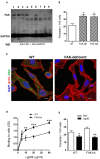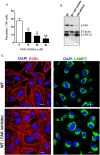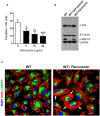Depletion of Host Cell Focal Adhesion Kinase Increases the Susceptibility to Invasion by Trypanosoma cruzi Metacyclic Forms
- PMID: 31297342
- PMCID: PMC6607697
- DOI: 10.3389/fcimb.2019.00231
Depletion of Host Cell Focal Adhesion Kinase Increases the Susceptibility to Invasion by Trypanosoma cruzi Metacyclic Forms
Abstract
Focal adhesion kinase (FAK), a cytoplasmic protein tyrosine kinase (PTK), is implicated in diverse cellular processes, including the regulation of F-actin dynamics. Host cell F-actin rearrangement is critical for invasion of Trypanosoma cruzi, the protozoan parasite that causes Chagas disease. It is unknown whether FAK is involved in the internalization process of metacyclic trypomastigote (MT), the parasite form that is important for vectorial transmission. MT can enter the mammalian host through the ocular mucosa, lesion in the skin, or by the oral route. Oral infection by MT is currently a mode of transmission responsible for outbreaks of acute Chagas disease. Here we addressed the question by generating HeLa cell lines deficient in FAK. Host cell invasion assays showed that, as compared to control wild type (WT) cells, FAK-deficient cells were significantly more susceptible to parasite invasion. Lysosome spreading and a disarranged actin cytoskeleton, two features associated with susceptibility to MT invasion, were detected in FAK-deficient cells, as opposed to WT cells that exhibited a more organized F-actin arrangement, and lysosomes concentrated in the perinuclear area. As compared to WT cells, the capacity of FAK-deficient cells to bind a recombinant protein based on gp82, the MT surface molecule that mediates invasion, was higher. On the other hand, when treated with FAK-specific inhibitor PF573228, WT cells exhibited a dense meshwork of actin filaments, lysosome accumulation around the nucleus, and had increased resistance to MT invasion. In cells treated with PF573228, the phosphorylation levels of FAK were reduced and, as a consequence of FAK inactivation, diminished phosphorylation of extracellular signal-regulated protein kinases (ERK1/2) was observed. Fibronectin, known to impair MT invasion, induced the formation of thick bundles of F-actin and ERK1/2 dephosphorylation.
Keywords: Trypanosoma cruzi; actin cytoskeleton; focal adhesion kinase; host cell invasion; lysosome distribution; metacyclic trypomastigote.
Figures





Similar articles
-
Host cell protein LAMP-2 is the receptor for Trypanosoma cruzi surface molecule gp82 that mediates invasion.Cell Microbiol. 2019 May;21(5):e13003. doi: 10.1111/cmi.13003. Epub 2019 Jan 17. Cell Microbiol. 2019. PMID: 30609224 Free PMC article.
-
Inhibition of Host Cell Lysosome Spreading by Trypanosoma cruzi Metacyclic Stage-Specific Surface Molecule gp90 Downregulates Parasite Invasion.Infect Immun. 2017 Aug 18;85(9):e00302-17. doi: 10.1128/IAI.00302-17. Print 2017 Sep. Infect Immun. 2017. PMID: 28607099 Free PMC article.
-
Host cell invasion mediated by Trypanosoma cruzi surface molecule gp82 is associated with F-actin disassembly and is inhibited by enteroinvasive Escherichia coli.Microbes Infect. 2006 May;8(6):1502-12. doi: 10.1016/j.micinf.2006.01.007. Epub 2006 Apr 5. Microbes Infect. 2006. PMID: 16697683
-
Trypanosoma cruzi infection by oral route: how the interplay between parasite and host components modulates infectivity.Parasitol Int. 2008 Jun;57(2):105-9. doi: 10.1016/j.parint.2007.12.008. Epub 2007 Dec 23. Parasitol Int. 2008. PMID: 18234547 Review.
-
The gp82 surface molecule of Trypanosoma cruzi metacyclic forms.Subcell Biochem. 2014;74:137-50. doi: 10.1007/978-94-007-7305-9_6. Subcell Biochem. 2014. PMID: 24264244 Review.
Cited by
-
Interaction of Trypanosoma cruzi Gp82 With Host Cell LAMP2 Induces Protein Kinase C Activation and Promotes Invasion.Front Cell Infect Microbiol. 2021 Mar 12;11:627888. doi: 10.3389/fcimb.2021.627888. eCollection 2021. Front Cell Infect Microbiol. 2021. PMID: 33777840 Free PMC article.
-
All Roads Lead to Cytosol: Trypanosoma cruzi Multi-Strategic Approach to Invasion.Front Cell Infect Microbiol. 2021 Mar 5;11:634793. doi: 10.3389/fcimb.2021.634793. eCollection 2021. Front Cell Infect Microbiol. 2021. PMID: 33747982 Free PMC article. Review.
-
Host Cell Rap1b mediates cAMP-dependent invasion by Trypanosoma cruzi.PLoS Negl Trop Dis. 2023 Mar 10;17(3):e0011191. doi: 10.1371/journal.pntd.0011191. eCollection 2023 Mar. PLoS Negl Trop Dis. 2023. PMID: 36897926 Free PMC article.
-
Mechanism of the Passage of Angiostrongylus cantonensis across the Final Host Blood-Brain Barrier Using the Next-Generation Sequencing.Iran J Parasitol. 2021 Jul-Sep;16(3):454-463. doi: 10.18502/ijpa.v16i3.7099. Iran J Parasitol. 2021. PMID: 34630591 Free PMC article.
-
Artesunate alleviates myocardial ischemia/reperfusion-induced myocardial necrosis in rats and hypoxia/reoxygenation-induced apoptosis in H9C2 cells via regulating the FAK/PI3K/Akt pathway.Ann Transl Med. 2020 Oct;8(20):1291. doi: 10.21037/atm-20-5182. Ann Transl Med. 2020. PMID: 33209871 Free PMC article.
References
-
- Brener Z., Chiari E. (1963). Variacões morfol6gicas observadas em diferentes amostras de Trypanosoma cruzi. Rev. Inst. Med. Trop. Sao Paulo 5, 220–224. - PubMed
Publication types
MeSH terms
Substances
LinkOut - more resources
Full Text Sources
Molecular Biology Databases
Research Materials
Miscellaneous

